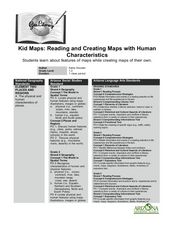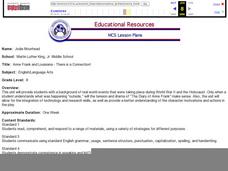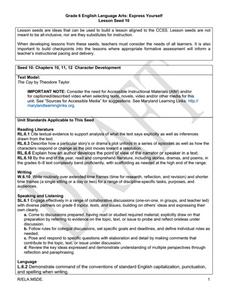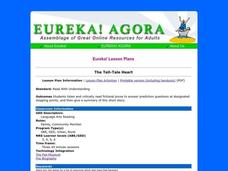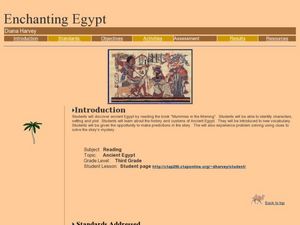Curated OER
This Place is Just Like the Other
Students write paragraphs that compare and contrast the geographical characteristics of Arizona and the Southwest region. In this geographical characteristics lesson plan, students complete a diagram and discuss how Arizona differs from...
Curated OER
Kid Maps: Reading and Creating Maps with Human Characteristics
Students look at maps. In this map lesson, students listen to the book My Map Book by Sara Fanelli and they see the difference between human characteristics (buildings, etc.) and natural characteristics (rivers, etc.). They...
Curated OER
In a Nutshell....
Young scholars examine how to summarize the most important details in a reading passage in order to increase their comprehension. They design a story web using the summarization skills. Before class, they complete a reading assignment...
Curated OER
Every Object Tells a Story
Students read the story behind objects in the Cooper-Hewitt National Design Museum and create a story about an object in the exhibit. In this design lesson, students explore the "Design for the Other 90%" exhibition and create a...
Curated OER
Patriots of the Revolution
Fifth graders identify causes and effects of historical events in the American Revolution. They evaluate critical issues and events that led to the American Revolution. Analyze the views and lives of people of the Revolutionary Period.
Curated OER
The Birth of a Rocky Mountain City and Railroad: Georgetown and the Loop Railroad
Learners explore the evolution of a town. In this social studies lesson, students discuss why Georgetown and the Georgetown Loop Railroad were developed and discuss life as a prospector. Learners write a letter explaining what life is...
Curated OER
Through Time: Change in Sedona
Students locate events on a timeline of Sedona, Arizona and describe human and physical characteristics of the city. For this Sedona lesson plan, students locate the city on a map and listen to stories about Sedona.
Curated OER
Indians of the Plains
Second graders, in groups, explore the Plains Indians and explore how the physical climate of the Plains region affected their lives.
Curated OER
The Seminoles
Students explore the Southeast Woodland region and culture of the Seminole Indians using video, art projects, books, maps and discussion.
Curated OER
Waddle You Know About Penguins
Second graders study the similarities and differences of the seventeen species of penguins. They investigate habitats and how these habitats are suited to each species characteristics. They see how animals adapt to their environments.
Curated OER
The Secret School: chapter 11
Fourth graders read chapter 11 of The Secret School and answer discussion questions as they read. In this reading lesson plan, 4th graders also write a summary of what they read and complete a crossword puzzle..
Curated OER
Me on the Map: Homes, Neighborhoods, and Communities
Students read a book about maps and identify the differences between a picture and a map. For this maps lesson plan, students also label maps of their home, neighborhood, and community.
Curated OER
Doodle Splash
Students navigate Doodle Splash to create a painting. In this doodle splash lesson, students explain their splash painting relationship to a piece of literature.
Curated OER
Desert Views: First Impressions
Pupils are introduced to primary source material and the ways in which early travelers viewed aspects of the desert environment. The lesson addresses the geography themes of location, region, and human/environment interaction.
Curated OER
Anne Frank and Louisiana - There is a Connection!
How is Louisiana connected to the Holocaust? After reading The Diary of Anne Frank, eighth graders complete a research report about a survivor of the Holocaust who currently resides in Louisiana. Though the idea is a good way to...
Curated OER
Characteristics of Anne Frank
Eighth graders read selected passages from The Diary of Anne Frank. Working in pairs, 8th graders determine what qualities and characteristics they would assign to her from their selected diary entry.
Curated OER
Lights, Camera, Campaign
Students employ their technology skills to produce campaign commercials. In this political campaign lesson, students discover the appropriate uses of video cameras and create fictitious campaign commercials.
Curated OER
Express Yourself Lesson Seed 8: Character
Characters often change over the course of a story or novel. Use the sample graphic organizer provided here to track how the narrator has responded to the sequence of events in chapter four through six of The Cay. In addition to this...
Curated OER
Express Yourself Lesson Seed 10: Character Development
Make a study of Timothy and his development as a character over the course of the first half or so of The Cay. This idea focuses in particular on chapters 10 through 12. Learners start out by working on double-entry journals created in...
Curated OER
The Tell-Tale Heart
Readers listen and critically read fictional prose to answer prediction questions at designated stopping points, and then they give a summary of the short story. This lesson is ideal for English language learners developing English...
Curated OER
Examining Women's Roles through Primary Sources and Literature
Students interpret historical evidence presented in primary resources. In this women's history lesson, students examine the role of women prior to and following the suffrage movement. Students also read selected pieces of women's...
Curated OER
As the Kids Come and Go: Mapping a Classroom
Map the classroom with your kids to help them understand how maps work and how to read them. The lesson starts off with a story about animals living and moving around the globe, and then kids create maps of their classroom to show how...
Curated OER
Enchanting Egypt
After reading the Magic Tree House book Mummies in the Morning, learners talk about Ancient Egypt. They identify the plot, characters, setting, etc., explore vocabulary terms, and construct a pyramid. This will motivate your class...
Curated OER
Prepare to Read Nonfiction
Students explore the components of a KWL chart as they examine the facts of a story about the Leaning Tower of Pisa. Vocabulary from additional stories is utilized to form antonyms and synonyms.



